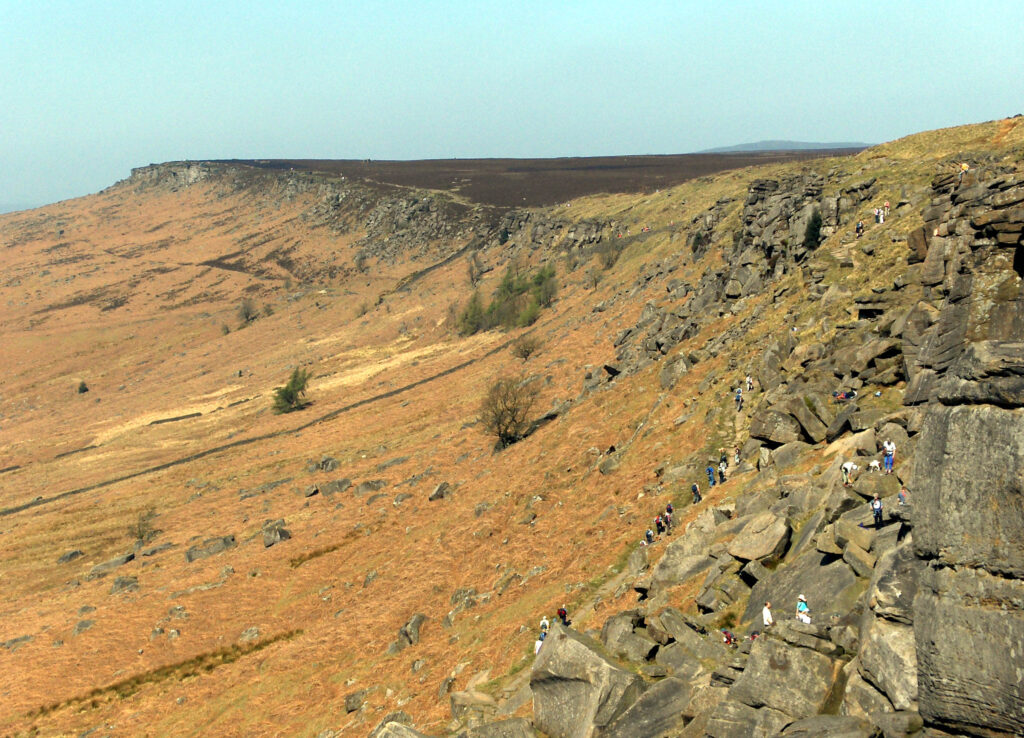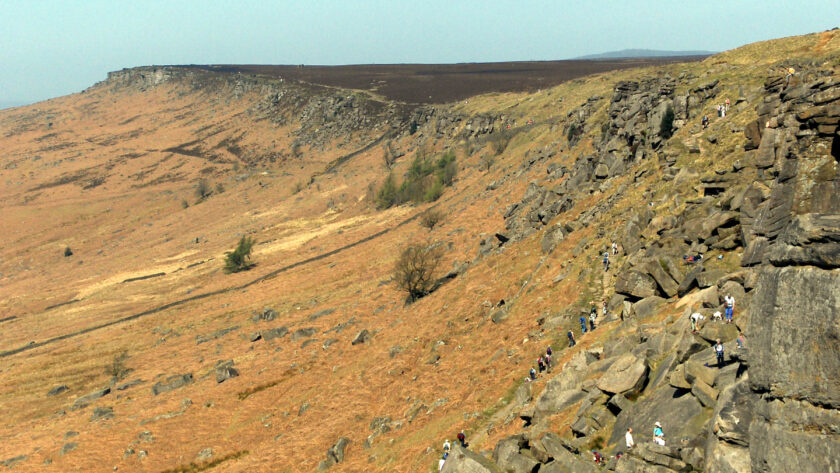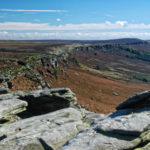Stanage Edge is a prominent gritstone escarpment located in the Peak District National Park in Derbyshire, England. It stretches for approximately four miles (6.5 kilometers) and is a popular destination for hikers, rock climbers, and nature enthusiasts. The history of Stanage Edge is intertwined with the cultural, geological, and industrial developments of the region.

Geologically, Stanage Edge owes its formation to millions of years of natural processes. The gritstone that forms the edge was deposited during the Carboniferous period, around 300 million years ago when the area was covered by a shallow sea. Over time, layers of sand and sediment built up, and with the pressure of subsequent geological activity, they solidified into the hard gritstone we see today.
The name “Stanage” is derived from the Old English words “stan” (meaning stone) and “edge” (meaning ridge or escarpment), reflecting the prominent rocky nature of the landscape. While the area has likely been inhabited for thousands of years, the recorded history of Stanage Edge begins in the medieval period.
During the Middle Ages, the surrounding region was primarily used for farming and grazing livestock. The edge provided a natural boundary and was an important landmark for local communities. It is believed that the edge was also used for quarrying, with the gritstone being extracted for construction purposes.
In the 16th and 17th centuries, Stanage Edge gained significance in the context of the burgeoning lead mining industry in the Peak District. Lead was a valuable resource, and the mineral veins beneath Stanage Edge were exploited. Miners constructed tunnels, or adits, to access the lead-bearing veins. Remnants of these mining activities can still be seen in the form of shafts and spoil heaps along the edge.
Stanage Edge’s association with rock climbing dates back to the late 19th century. The edge’s exposed gritstone cliffs and crags attracted early pioneers of the sport who sought challenging routes. It became one of the birthplaces of modern rock climbing in the UK. Renowned climbers like Siegfried Herford and Walter Parry Haskett Smith explored and established many routes, setting the stage for the development of rock climbing as a recreational pursuit.
During the Industrial Revolution in the 18th and 19th centuries, the Peak District underwent significant changes due to the growth of textile mills, factories, and mining operations. Stanage Edge was not immune to these developments. Quarries expanded, and the edge became an important source of gritstone for construction, including millstones, grindstones, and building materials.
The advent of the railway in the 19th century facilitated the transportation of goods, including stone, which led to increased demand for quarrying. However, by the early 20th century, the demand for gritstone declined, and quarrying activities diminished. Today, the quarries are mostly abandoned, leaving behind a fascinating historical legacy visible along Stanage Edge.
In the 20th century, Stanage Edge’s popularity as a recreational destination grew, attracting walkers, climbers, and tourists from far and wide. The landscape’s rugged beauty and cultural significance were recognized, leading to its designation as part of the Peak District National Park in 1951, the first national park in the United Kingdom.
Stanage Edge continues to be a hub for outdoor activities, including rock climbing, bouldering, hiking, and birdwatching. Its accessibility, diverse flora and fauna, and stunning panoramic views of the surrounding countryside make it a cherished natural landmark and a place of immense cultural and historical value.
In recent years, efforts have been made to preserve and protect Stanage Edge’s unique character and delicate ecosystems. Conservation projects, land management



